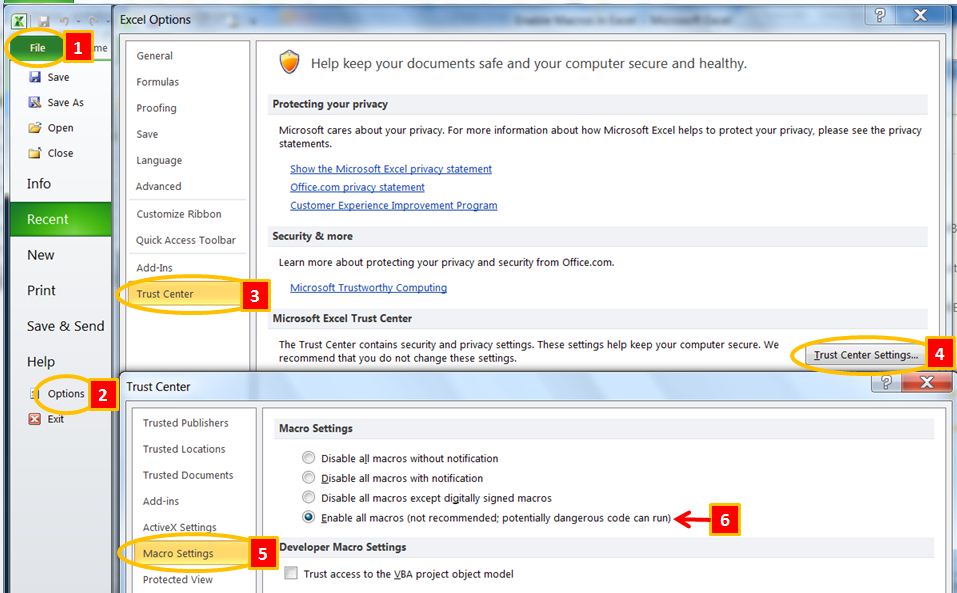
The short code snippets below will help you apply some of the most common chart options with VBA (and hopefully turn those hours into minutes).The Developer tab, which is a built-in tab in Excel, provides the features. When we want to apply those hundreds of settings to lots of charts, it can take hours and hours of frustrating clicking. This is great for creating precisely the visualization we want but can be time-consuming to apply. The DEVELOPER tab is the toolbar that has the buttons to open the VBA editor and create Form/ActiveX Controls like buttons, checkboxes, etc.Charts and graphs in Excel have hundreds of different options. First, be sure that the DEVELOPER tab is visible in the toolbar in Excel. You can access the VBA environment in Excel 2013 by opening the Microsoft Visual Basic for Applications window.
There is a slight difference for Excel for Mac, which will be detailed below. The process for enabling macros is the same for Excel 2010, 2013, and 2016. Click the Customize Ribbon tab, select the.Open Excel. But once you’ve mastered it, you’ll know the situations when VBA is the best option.How to Record New Macros in Excel 2013 Choose FileOptions or press Alt+FT to open the Excel Options dialog box.
In Excel 2013 they finally add a new.In Excel 2013, many changes were introduced to the charting engine and DOM. See the argument 21 that they add in Excel 2010. Understanding Excel’s Document Object Model (DOM) is essential to understand how VBA can be used with charts.Excel 2007-2016: On the Developer tab click on Record macro. Click the Customize Ribbon option.While it might be tempting to skip straight to the section you need, I recommend you read the first section in full. In Excel for Mac, click the 'Preferences' menu option.
To change the height of Chart 1, on Sheet1, we could use the following. For example:Therefore, to change a cell color to red, we would reference this as follows: ActiveWorkbook.Sheets("Sheet1").Range("A1").Interior.Color = RGB(255, 0, 0)Charts are also part of the DOM and follow similar hierarchical principles. Understanding the Document Object ModelThe Document Object Model (DOM) is a term which describes how things are structured. By applying the principles and methods in this post, you will be able to do almost anything you want with charts in Excel using VBA. Adapting the code to your requirementsIt is not feasible to provide code for every scenario you might come across there are just too many options. As a result, some of the code presented in this post may not work with versions before Excel 2013.
The parent of a ChartObject is a Sheet, and the Parent of a Sheet is a Workbook. ActiveWorkbook.ChartObjects("Chart 1").Height = 300In the DOM, the ActiveWorkbook does not contain ChartObjects, so Excel cannot find Chart 1. ).While the following code may look acceptable, it will not work.
For example, a chart can be an embedded chart of the face of a worksheet, or as a separate sheet. Chart SheetsOne of the things which makes the DOM for charts complicated is that many things exist in many places. Sheets("Sheet1").ChartObjects("Chart 1").Height = 300With this knowledge, we can refer to any element of any chart using Excel’s DOM.
Chart on a worksheet: Sheets("Sheet1").ChartObjects("Chart 1").Chart. A Chart is also a stand-alone sheet it does not have a ChartObject around it.This may seem confusing initially, but there are good reasons for this.To change the chart title text, we would reference the two types of chart differently: Effectively a ChartObject is a container which holds a Chart. Within each ChartObject is a Chart.



Writing Ros In Excel 2013 How To Read And
Consistent code layout between examples to enable you to understand the structure and easily customize the code to meet your needs. An introduction to macros in Excel to ensure you can implement the VBA code in the book even if you have no prior knowledge. 100 example codes to practice reading and writing macros that will embed the language into your thinking. It’s the book for all Excel users who want to learn how to read and write Excel macros, save time, and stand out from their peers. That is why the 100 Excel VBA Macros eBook exists. The more you immerse yourself in that language, the faster you will pick it up.Therefore, what most people like you need is lots of examples that you can practice.
'Set chart axis min and maxCht.Axes(xlValue).MaximumScaleIsAuto = TrueCht.Axes(xlValue).MinimumScaleIsAuto = TrueCht.HasAxis(xlValue, xlSecondary) = FalseCht.Axes(xlCategory, xlSecondary).HasTitle = TrueCht.Axes(xlCategory).AxisTitle.Text = "My Axis Title"Cht.Axes(xlCategory).ReversePlotOrder = True Gridlines 'Add gridlinesCht.SetElement (msoElementPrimaryValueGridLinesMajor)Cht.SetElement (msoElementPrimaryCategoryGridLinesMajor)Cht.SetElement (msoElementPrimaryValueGridLinesMinorMajor)Cht.SetElement (msoElementPrimaryCategoryGridLinesMinorMajor)Cht.Axes(xlCategory).MinorGridlines. To adapt the code to your specific requirements you need to change the value in the brackets.


 0 kommentar(er)
0 kommentar(er)
